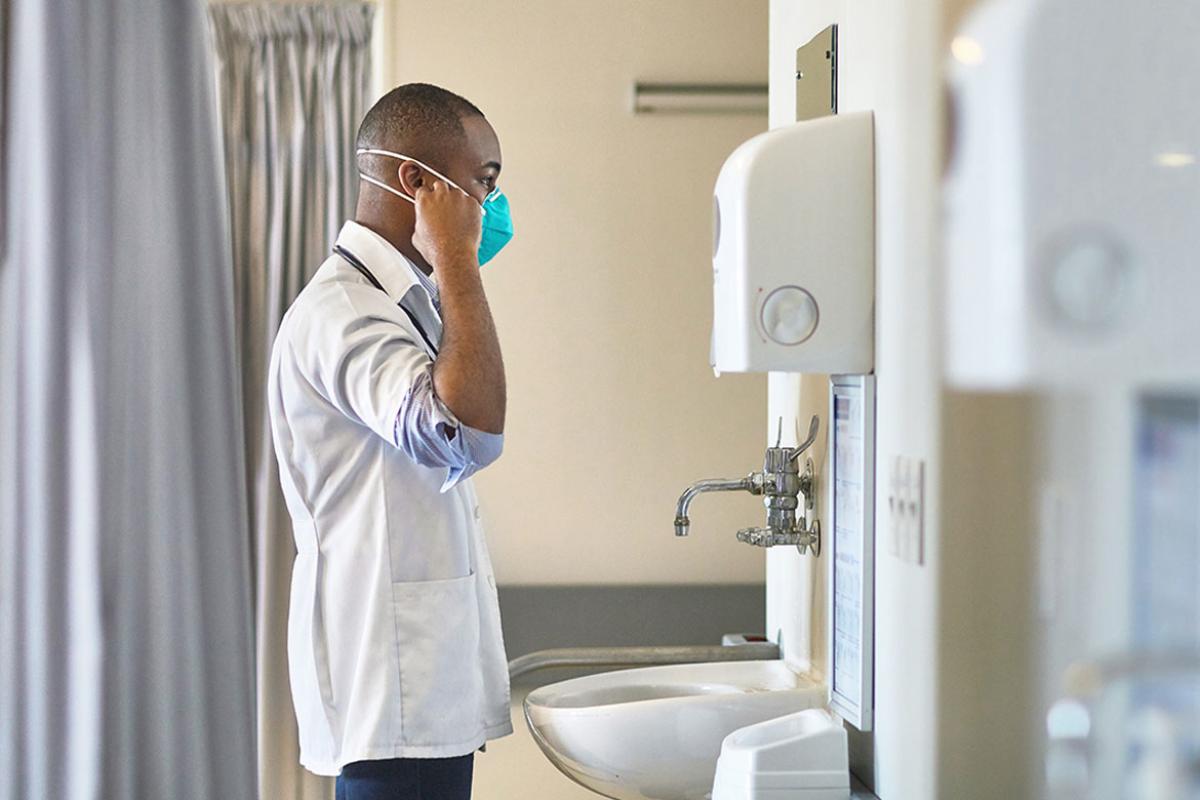As a medical student, do you ever wonder what it’s like to specialize in hospital medicine? Meet Clyde J. (C.J.) Pierce, MD, a hospitalist and a featured doctor in the AMA’s “Shadow Me” Specialty Series, which offers advice directly from physicians about life in their specialties. Check out his insights to help determine whether a career in hospital medicine might be a good fit for you.
The AMA Specialty Guide simplifies medical students’ specialty selection process, highlights major specialties, details training information, and provides access to related association information. It is produced by FREIDA™, the AMA Residency & Fellowship Database®.
Learn more with the AMA about the medical specialty of internal and hospital medicine.
“Shadowing” Dr. C.J. Pierce
Specialty: Internal and hospital medicine.
Practice setting: Hospital.
Employment type: Employed by Wenatchee Valley Medical Group, a multispecialty physician group in partnership with Confluence Health, which is a member of the AMA Health System Program that provides enterprise solutions to equip leadership, physicians and care teams with resources to help drive the future of medicine.
Years in practice: Seven.
A typical day and week in my practice: My typical workday begins around 6:50 a.m.—it’s always a good idea to be a bit early. My shifts begin at 7 a.m., and we are responsible for all communications with, and management of, our patients for a 12-hour period. This doesn’t necessarily mean being in the hospital for that entire time frame, but at least being available via pager or phone. Our hospitalist teams consist of a physician and a physician assistant, with the occasional medical student or resident, and we are responsible for the management of 20–21 inpatients.
To begin the day, I listen to messages and converse with the nocturnist team regarding patients admitted overnight or any acute events with our patients, after which we spend a few hours reviewing charts and rounding on patients. At 10:30 a.m., we participate in multidisciplinary rounds, which include bedside nurses, pharmacists, therapists and case managers. This lasts about an hour, which is a refreshing change from the never-ending rounds of academic medicine that most are subjected to in residency.
After morning rounds, the day is spent following up with consultants, patients and patients’ family members to ensure outstanding care and clear communication. On a typical day on the medical floor, somewhere between four and eight of our patients will be discharged to their home or a nursing facility. The worst part of the day is always documentation in the EMR, which is the bane of most medical physicians. Usually, I will spend several hours dictating notes, typically concluding my day on the medical floor between 5 and 6 p.m.
On weeks when I work as a hospitalist-intensivist in our intensive care unit (ICU), the day is a bit longer and almost always ends after 7 p.m. because, in addition to the duties mentioned above, I am also responsible for managing decompensating patients on the medical floor, including those with codes and intubations, and admitting critically-ill patients as transfers from outlying critical access hospitals.
In our group, a full-time hospitalist works 15 shifts per month, and the shifts are often divided up into two runs of five to seven days each on the medical floors, with a few other shifts doing admissions. I tend to do a week in the ICU and then a shorter five-day run on one of our several medical floors. During admission shifts, hospitalists are responsible for admitting patients from the emergency department or outside hospitals from either 7 a.m.–2 p.m. or 2–7 p.m. Typically, we will admit six to nine patients on an admission shift.
Most hospitalist groups, however, work on a “seven on, seven off” schedule, which is exactly how it sounds. Some folks love the ease of this scheduling, though others find it fairly constricting. I specifically sought out a hospital that does not pursue this type of schedule.
The most challenging and rewarding aspects of hospital medicine: The most challenging aspect of hospitalist work is rapidly assessing a situation—not just the medical diagnosis, but also the patient factors, family dynamics and social circumstances—and quickly building rapport and trust, particularly when patients are most vulnerable.
The most rewarding aspect of caring for patients as a hospitalist is the ability to see tangible results and clinical improvement in a relatively short period of time. Typically, this paradigm of “find problem, fix problem” is appreciated by surgical specialties, but not by internists who know patients over years or decades. In the hospital, and particularly in the ICU cohort, it is quite gratifying to see patients with septic shock and ventilator-dependent respiratory failure clinically improve to the point where they walk out on their own within a few weeks.
Tangentially, it is very empowering and rewarding to know that, during what is often the most difficult time in a person's life, your words, your gestures, your time and your compassion have such a profound impact.
The impact burnout has on hospital medicine: As a hospitalist, I would say the greatest source of burnout is not medical issues or patient census, but rather patient-specific social dynamics or system-based social issues. My worst weeks on the medical floor are due to mental or emotional exhaustion directly related to multiple circular discussions with family members about complex family dynamics or social circumstances.
For example, it is quite easy to manage the pain in a patient dying from metastatic cancer, but it is very different to spend multiple visits over multiple hours meeting with numerous family members who are manifesting their fear or lack of understanding of a situation as anger toward physicians and other health professionals.
Additionally, it becomes exhausting to deal with the never-ending issues pertaining to discharge planning in vulnerable populations—such as people who are elderly, cognitively impaired or without housing. It is substantially easier to manage 12 patients on ventilators and vasopressors than 20 patients who clinically no longer require hospitalization but have no place to go.
How Confluence Health is reducing physician burnout: My specialty reduces burnout on its own with copious time off. Confluence Health has contracted with a third party that is available for counseling, career coaching and other assistance. Additionally, we have peer-to-peer counseling programs that are discreet and widely available.
How my lifestyle matches, or differs from, what I had envisioned: I will preface this by noting that I absolutely did not plan on becoming a hospitalist upon starting medical school. My initial impression of the specialty was actually quite negative, and I saw it as a “jack of all trades, master of none” profession that involved a lot of scut work and disrespect from other specialists.
Now that I am a decade out of medical school, while I believe that this view of a hospitalist’s work is sometimes accurate, I could not be happier with my decision to become a hospitalist. If you value work-life balance, which seems to be emphasized more and more with young physicians, I don’t think there is a better specialty. For half of each month, I am off 100%. When we work, we work hard and, as mentioned previously, sometimes this work can be mentally and emotionally exhausting. The flip side, though, is that when you are off, you are off. I don’t take call. I don’t receive inbox messages from patients. I don’t worry about prior authorizations. When I am home, I am not thinking about the hospital whatsoever, and there are times when I may not work for 10–14 days at a time.
Also, when you consider compensation per unit of time worked, hospitalists are probably some of the best-compensated physicians. You will never make a million dollars per year, but you can live very comfortably while enjoying maximal time off work. For those without families, this is an ideal specialty for pursuing travel opportunities. If you are thinking about starting a family, it is very conducive to being present and involved in your kids’ lives.
I began working as a newlywed attending hospitalist in 2017. My wife and I now have two beautiful girls, 5 and 3, and—more often than not—I have the pleasure of spending full days with them, which cannot be said of most medical specialties. Regarding hobbies, this lifestyle is outstanding for pursuing interests outside of medicine. Depending on the season, I am skiing, mountain biking or hiking nearly every day I am not at work.
Skills every physician in training should have for hospital medicine but won’t be tested for on the board exam: The obvious answer is the ability to be flexible and to multitask. The beauty of the day-to-day is that you can set up your time however you like, and there is no rigid schedule or stressful time constraint, as you may see in clinic.
The most important skill, however, is the ability to communicate, a talent that is as overlooked as it is obvious. Anybody can get through medicine and pass the tests, but the best hospitalists, and physicians in general, I know are the ones who can read a room, communicate clearly and advocate in a coherent manner.
One question physicians in training should ask themselves before pursuing hospital medicine: Are you OK with being a “jack of all trades, but master of none”? Another: Can you multitask efficiently?
Books, podcasts or other resources every medical student interested in hospital medicine should be reading:
- The House of God, by Samuel Shem, the pen name of Stephen Bergman, MD, PhD. It is obviously a bit dated, with subject matter that is controversial in our time, but it is a must-read for any hospitalist. It is my favorite piece of fiction.
- Being Mortal, by Atul Gawande, MD, MPH. This should be required reading for any primary care physician in the current era of medicine.
- "The Internet Book of Critical Care Podcast.” This is perhaps a bit too critical care-focused, but it is my favorite medical podcast to listen to while biking or hiking.
Additional advice I would give to students who are considering hospital medicine: Rather than focusing on the one or two things you think you love about a particular specialty—such as pathology, money, prestige or time off—pay attention to the things that are deal-breakers. In other words, if you don’t do well with tight time windows to see patients, a clinic-based specialty probably isn’t for you. Intrinsically, medicine is a tough job. There are pros and cons in every field. With the focus on burnout … it is paramount that you identify the things you personally can’t tolerate and avoid them.




